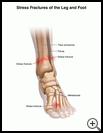
Stress Fractures
________________________________________________________________________
KEY POINTS
- A stress fracture is a crack in a bone usually caused by overuse—for example, from running a lot of miles or jumping in basketball.
- Treatment may include wearing a cast, splint, or removable boot for several weeks. Sometimes surgery is needed to put the bones back into place and to make them stronger.
- Follow the full course of treatment your healthcare provider prescribes.
________________________________________________________________________
What is a stress fracture?
A stress fracture is a crack in a bone caused by repeated or prolonged use. The most common sites for a stress fracture are bones in the foot, leg, hip, and back.
What is the cause?
Stress fractures usually happen from overuse—for example, from running a lot of miles or jumping in basketball. A fracture may also be the result of a medical condition that causes weak or brittle bones.
What are the symptoms?
Symptoms may include:
- Pain
- Swelling
- Bruising
How is it diagnosed?
Your healthcare provider will ask about your symptoms and how the injury happened. Your provider will examine you. Tests may include:
- X-rays
- CT scan, which uses X-rays and a computer to show detailed pictures of the bones
- MRI, which uses a strong magnetic field and radio waves to show detailed pictures of the bones
- Bone scan, which uses a radioactive chemical to look at your bones
How is it treated?
The treatment depends on the type of fracture.
- You may need to have a cast, splint, or removable boot for several weeks.
- If you have a cast, make sure the cast does not get wet. Cover the cast with plastic when you bathe. Avoid scratching the skin around the cast or poking things down between the cast and your skin. This could cause an infection.
- Your provider will tell you how much weight you can put on the injured area, if any. Use crutches, a knee walker, or a cane as directed by your healthcare provider.
- Sometimes surgery is needed to put the bones back into place and to make them stronger.
The time it takes for your stress fracture to heal depends on the location. You may need to do special exercises to help you get stronger and more flexible. Ask your healthcare provider about this.
How can I take care of myself?
Follow the full course of treatment your healthcare provider prescribes. The most important treatment for a stress fracture is rest. Also:
- To keep swelling down and help relieve pain, your healthcare provider may tell you to:
- Put an ice pack, gel pack, or package of frozen vegetables wrapped in a cloth on the injured area every 3 to 4 hours for up to 20 minutes at a time for the first day or two after the injury.
- If the injury is to your arm or leg, keep your arm or leg up on pillows so that it is above the level of your heart when you sit or lie down.
- Take pain medicine, such as ibuprofen, as directed by your provider. Nonsteroidal anti-inflammatory medicines (NSAIDs), such as ibuprofen, may cause stomach bleeding and other problems. These risks increase with age. Read the label and take as directed. Unless recommended by your healthcare provider, you should not take this medicine for more than 10 days.
- If you are a runner, run only if you don’t have any pain.
Ask your healthcare provider:
- How and when you will get your test results
- How long it will take to recover
- If there are activities you should avoid and when you can return to your normal activities
- How to take care of yourself at home
- What symptoms or problems you should watch for and what to do if you have them
How can I help prevent a stress fracture?
The best way to avoid stress fractures is to listen to your body and not force yourself to do activities when you are in pain. Also, eat a healthy diet. Foods such as low-fat milk and dairy products, green leafy vegetables, citrus fruits, sardines, and shellfish can help you get calcium. Calcium helps your bones stay healthy. Ask your healthcare provider about the best way for you to get the right amount of calcium and vitamin D every day.

